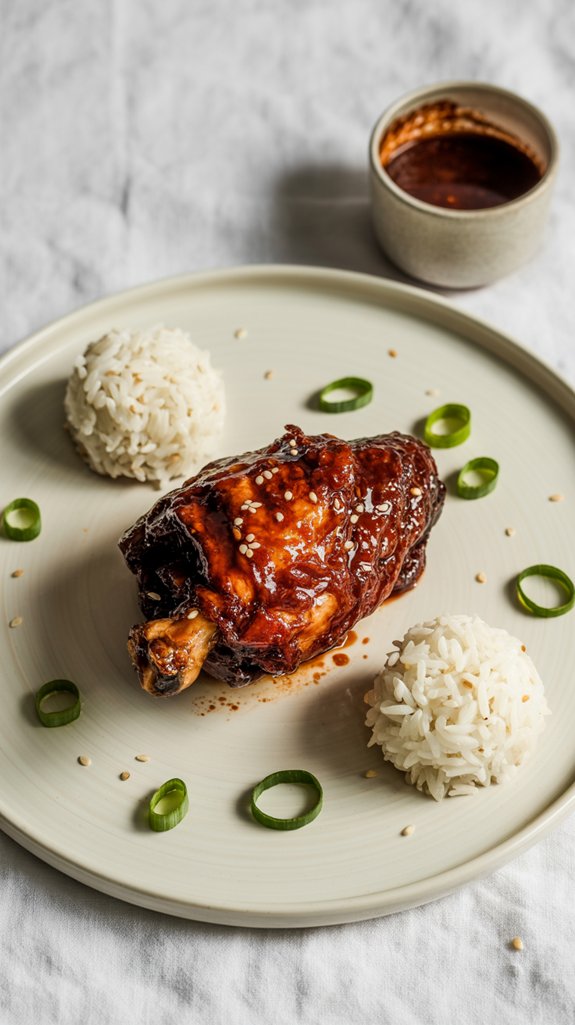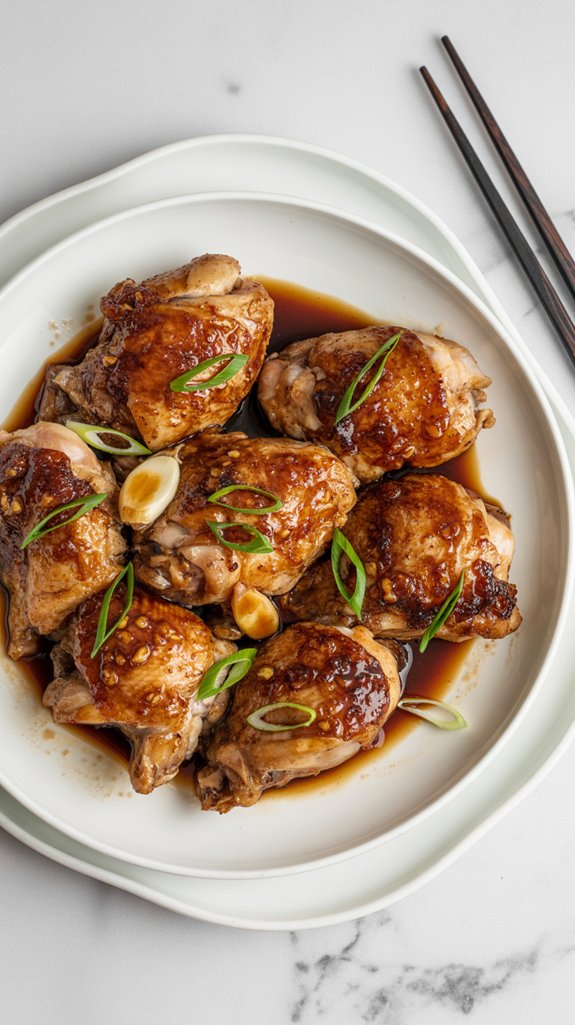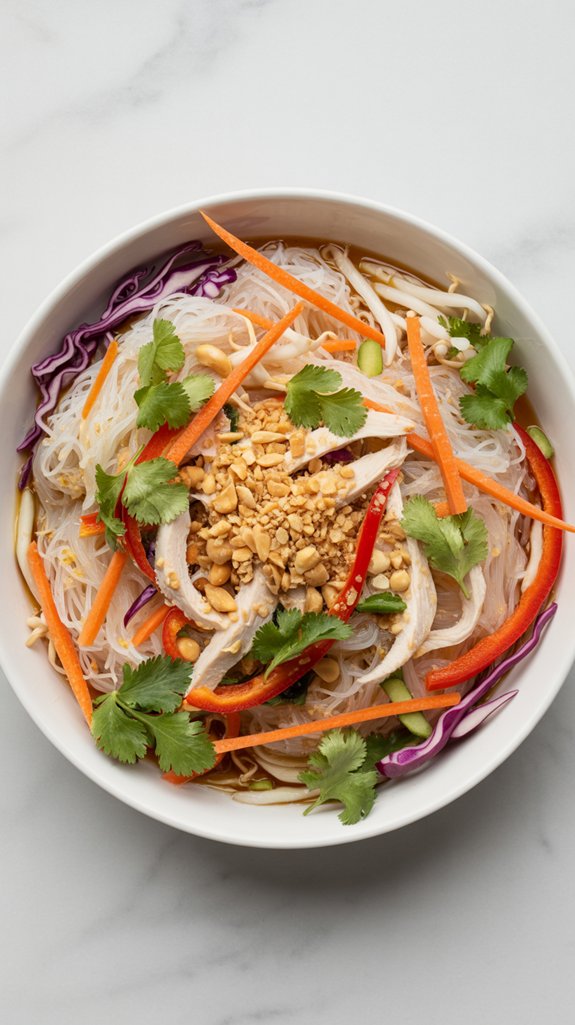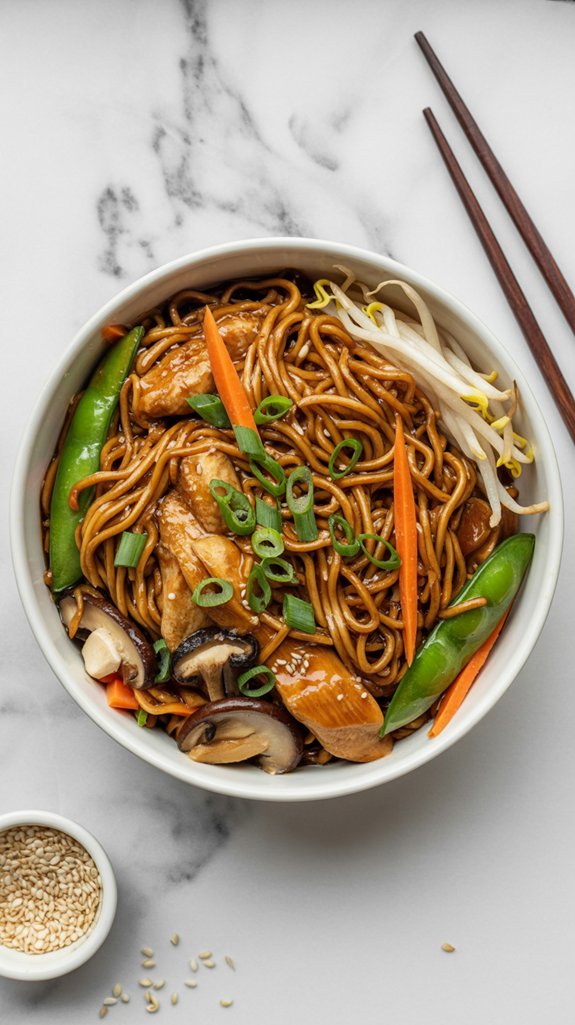Why You’ll Love This this Korean Gochujang Chicken
This Korean gochujang chicken hits that perfect sweet-spicy balance that makes you wonder why you ever settled for boring weeknight dinners.
The marinade does all the heavy lifting while you binge-watch your favorite show, then transforms into this gorgeous caramelized glaze that clings to every piece of tender chicken.
Plus, it’s one of those forgiving recipes where you can eyeball the ingredients and still end up with something that tastes like you actually know what you’re doing in the kitchen.
Ingredients List
Here’s everything you need to transform your kitchen into a Korean flavor paradise.
- 2-3 lbs boneless skinless chicken thighs
- 4-6 green onions
- 1 medium onion
- 1 ounce red chili paste (gochujang)
- 1 ounce soy sauce
- 1 ounce wine
- 1 ounce brown sugar
- 1 ounce corn syrup
- 1 tablespoon toasted sesame oil
- 1 tablespoon minced garlic
- 1 tablespoon Korean red chili pepper flakes (gochugaru)
- 1/4 teaspoon black pepper
- 1/4 teaspoon ginger powder
- 1/2 teaspoon finely minced ginger
- 2 tablespoons cooking oil
Ingredient Health Notes:
- Chicken thighs pack more flavor and stay juicier than breasts, plus they’re usually easier on your wallet
- Gochujang brings probiotics to the party, though the sodium content means this isn’t exactly a low-salt situation
- Fresh ginger and garlic offer anti-inflammatory benefits that help balance out the indulgence factor
- The brown sugar and corn syrup create that addictive caramelized coating, but you could dial back the sweetness if you’re watching sugar intake
Step by Step Directions
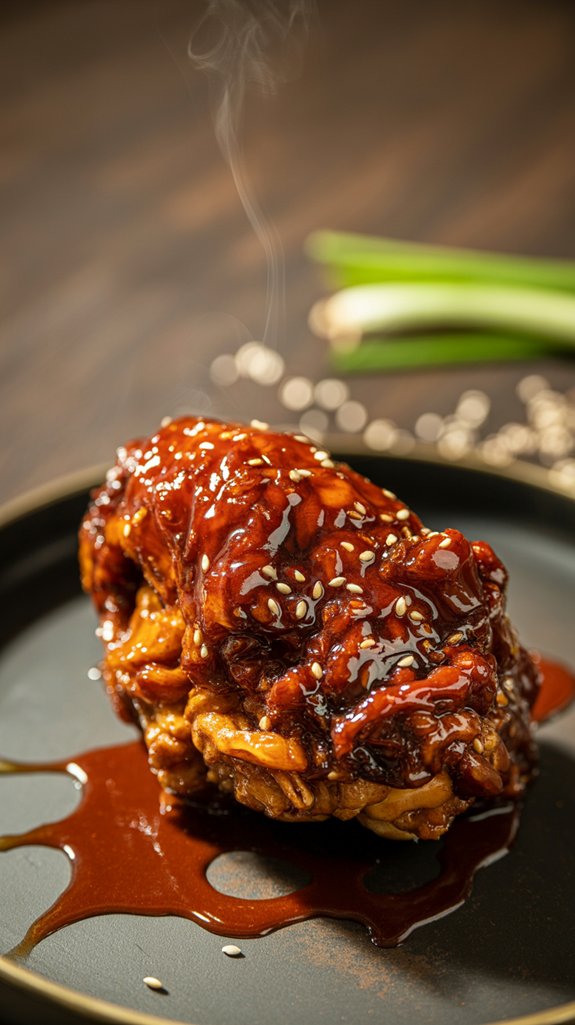
Transform your chicken into a Korean flavor bomb with this simple marinating and cooking process.
- Cut the chicken thighs into bite-sized pieces – Keep pieces uniform for even cooking.
- Mix the marinade ingredients – Combine gochujang, soy sauce, wine, brown sugar, corn syrup, sesame oil, minced garlic, gochugaru, black pepper, ginger powder, and fresh minced ginger in a medium glass bowl until well blended.
- Prepare the green onions – Cut green onion tops into 1-inch slices and thinly slice the white bottoms; thinly slice the medium onion.
- Marinate the chicken – Add chicken pieces and green onions to the marinade, toss to coat, then top with sliced onions and refrigerate for 2-6 hours.
- Start cooking the onions – Heat 2 tablespoons oil in a cast iron skillet or wok over medium-high heat, remove most onions from the marinade (squeeze out excess liquid), and cook for 3-5 minutes.
- Add chicken and finish cooking – Drain the marinade from chicken and green onions, add everything to the skillet with onions, and cook until chicken is cooked through and slightly caramelized.
For easier marinade preparation, consider using a premium kitchen stand mixer to thoroughly blend all the sauce ingredients until perfectly smooth.
Substitutions and Variations
- Heat level tweaks – Cut the gochugaru in half for sensitive palates, or double it if you’re one of those people who puts hot sauce on everything.
- Vegetable add-ins that make sense – Bell peppers, mushrooms, or snap peas thrown in during the last few minutes of cooking turn this into more of a complete meal.
- Fresh ginger vs. powder debate – Fresh ginger gives you more zing, but the powder version dissolves better into the marinade, so why not use both like the recipe suggests.
Additional Things to Serve With This Dish
This chicken is basically begging for some companions on the plate, and honestly, who are we to deny it what it wants.
- Steamed white rice – The classic move that never fails, plus it soaks up all that gorgeous sticky-sweet sauce that would otherwise just sit there looking pretty on your plate.
- Korean-style pickled vegetables (banchan) – Kimchi is the obvious choice, but pickled radish or cucumber cuts through all that rich, spicy goodness like a palate-cleansing superhero.
- Simple sesame spinach or blanched bok choy – Something green and mild to balance out the heat, because your mouth will thank you for the brief reprieve between bites.
- Crispy roasted vegetables – Brussels sprouts, broccoli, or carrots get all caramelized and sweet, which plays beautifully against the spicy chicken.
- Noodles instead of rice – Lo mein, udon, or even regular spaghetti work surprisingly well when you’re feeling like mixing things up a bit.
- A cold beer or iced tea – Trust me on this one, you’re going to need something invigorating to wash down all that heat.
Cooking Tips & Tricks (Chef’s Notes)
Look, I’m going to share some secrets that’ll turn you from a gochujang newbie into someone who makes this dish like they’ve been doing it their whole life.
- Don’t skip the marinating time – I know two hours feels like forever when you’re hungry, but that chicken needs time to really soak up all those flavors, and rushing it just means you’ll end up with sauce-coated chicken instead of properly seasoned meat.
- Pat the chicken dry before marinating – Wet chicken and marinade don’t play well together, it’s like trying to get paint to stick to a wet wall.
- Use a cast iron skillet if you have one – It gets screaming hot and stays that way, which means you’ll get those gorgeous caramelized edges that make the whole dish sing.
- Don’t crowd the pan – Cook in batches if you need to, because overcrowded chicken just steams and gets sad instead of getting that beautiful golden-brown color we’re after.
- Save some green onion tops for garnish – They look pretty, sure, but they also give you a fresh little pop of flavor right at the end when your taste buds are getting overwhelmed by all that heat.
- Taste the marinade before using it – Some gochujang brands are saltier or spicier than others, so you might need to adjust the soy sauce or add a touch more brown sugar to balance things out.
- Let the chicken rest for a few minutes after cooking – It keeps cooking a bit from residual heat, and the sauce thickens up just enough to coat everything perfectly.
Nutritional Facts
This protein-packed Korean dish delivers bold flavors with solid nutritional value per serving (recipe serves 4-6).
- Calories: Approximately 320-380 per serving
- Protein: 28-32 grams (excellent source for muscle maintenance and growth)
- Carbohydrates: 12-15 grams (primarily from brown sugar and corn syrup)
- Fat: 18-22 grams (includes healthy fats from sesame oil)
- Sodium: 650-800mg (moderate to high due to soy sauce and gochujang)
- Fiber: 1-2 grams (from vegetables and chili peppers)
- Sugar: 8-10 grams (mainly from added sugars in marinade)
- Iron: 15% daily value (from chicken thighs)
- Vitamin B6: 25% daily value (supports metabolism)
- Niacin: 30% daily value (important for heart health)
- Selenium: 40% daily value (powerful antioxidant)
- Phosphorus: 20% daily value (bone and teeth health)
- Capsaicin: Present from gochujang and gochugaru (may boost metabolism)
- Healthy compounds: Allicin from garlic, gingerol from ginger (anti-inflammatory properties)
Fun “Did You Know?”
Ever wondered why gochujang has such a complex, addictive flavor? I’ll share fascinating facts about this Korean staple.
Gochujang takes months to ferment, developing its signature umami depth through natural processes. The paste contains beneficial probiotics that support gut health.
Here’s something surprising: traditional gochujang gets its sweetness from rice, not added sugar. Korean families often pass down gochujang recipes through generations, each with unique flavor profiles.
The fermentation process actually increases the bioavailability of nutrients, making this spicy condiment more nutritious than fresh peppers. That’s why gochujang chicken tastes so incredibly satisfying and complex.

